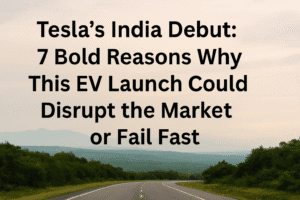Tesla’s India Debut: 7 Bold Reasons Why This EV Launch Could Disrupt the Market or Fail Fast
Tesla’s long-awaited India debut begins July 15th with a Mumbai showroom, marking a critical test for the brand in a price-sensitive market. Initially selling imported Model Y SUVs, Tesla faces a major hurdle: India’s steep ~70% import duties will push prices far beyond US levels, placing these EVs firmly in luxury territory. This strategy tests whether Indian consumers value Tesla’s tech and cachet enough to pay premium prices over established luxury brands or affordable domestic EVs.
The launch timing is strategic, coming as Tesla seeks new growth amid global sales pressure while India’s own EV market hits an inflection point. Despite past talks of local manufacturing, Tesla is starting cautiously with imports, using the Mumbai “experience centre” to gauge demand. Success hinges on overcoming the price-value perception gap and building service infrastructure. Ultimately, this entry challenges both consumer spending habits and India’s EV policy framework.

Tesla’s India Debut: 7 Bold Reasons Why This EV Launch Could Disrupt the Market or Fail Fast
The long-awaited “coming soon” post on Tesla India’s new X account isn’t just a marketing flourish – it’s the starting gun for one of the most closely watched automotive entries in recent memory. Tesla’s official debut in India, confirmed with a Mumbai showroom opening on July 15th, signals more than just another market expansion; it represents a high-stakes experiment in premium EV adoption within a price-sensitive landscape.
The Mumbai Milestone: Experience Over Immediate Sales
The Bandra Kurla Complex showroom, dubbed a “Tesla experience centre,” strategically focuses on immersion rather than instant transactions. Opening first to VIPs and partners before the general public (likely the following week), its initial purpose is clear: build desire and educate. Potential buyers will finally be able to configure options and see pricing – crucial steps for vehicles expected to carry a significant premium.
The Import Reality and the Price Hurdle
For now, Tesla’s India play revolves around imports, primarily the Model Y SUV. Early commercial records reveal modest imports (around $1 million worth of vehicles and chargers), including specific Model Y variants priced between $32,500 and $46,000 before India’s notorious import duties kick in. This is the critical challenge:
- The Duty Impact: India imposes approximately 70% import duty on cars under $40,000. This transforms a $32,500 Model Y into a vehicle potentially costing well over ₹50 lakhs (ex-showroom). Even higher-end models face steep 100% duties.
- The Brand vs. Value Proposition: Tesla enters a market where the dominant EV conversation centers around affordability (e.g., Tata Nexon EV, MG Comet). Can the allure of the Tesla brand, its technology (Autopilot, Supercharger network potential), and performance overcome a price point that places it firmly in luxury sedan/SUV territory, competing with established players like Mercedes, BMW, and Audi? This is Tesla’s core test in India.
Strategic Timing Amid Global Headwinds
Tesla’s India push comes at a pivotal moment:
- Global Sales Pressure: Facing slowing growth and underutilized factories in key markets like China, India represents a fresh growth frontier, albeit a complex one.
- India’s EV Inflection Point: While nascent (EVs are ~2% of total car sales), India’s EV market is growing rapidly, fueled by government incentives (FAME, state subsidies), rising urban environmental consciousness, and improving charging infrastructure (though still developing). Tesla’s entry adds significant cachet and could accelerate overall market maturity.
- The Manufacturing Question: Despite CEO Elon Musk’s past interest in a $2-3 billion Indian factory, the initial import-only strategy suggests caution. Tesla appears to be testing demand and navigating the policy landscape before committing to massive local investment. Recent hiring (store staff, service techs, and notably, supply chain engineers and vehicle operators) hints at laying groundwork for future scaling, potentially including local assembly or even manufacturing if volumes and policies align.
Beyond the Showroom: The Road Ahead
The opening on July 15th is just the first step. Key developments to watch include:
- Official Pricing: Revealed next week, this will be the single most critical factor shaping initial demand.
- Delivery Timelines: Can Tesla meet the late August target for the first Model Y deliveries?
- Service & Charging Infrastructure: Building a robust service network and a strategic Supercharger rollout will be vital for long-term customer confidence and adoption beyond major metros.
- Government Engagement: Will Tesla’s market entry spur further dialogue on import duty structures for EVs, especially as it considers potential future local manufacturing?
The Human Angle: Aspiration Meets Affordability
For Indian consumers, Tesla’s arrival sparks excitement but also practical questions. It represents access to a global icon of technology and sustainability.
However, the pricing reality forces a difficult calculation: Is the Tesla experience worth a significant premium over established luxury brands or vastly more affordable domestic EVs? Early adopters will likely be affluent tech enthusiasts and status seekers, but true mass-market impact hinges on future localization and price reductions.
Conclusion: More Than Just Cars
Tesla’s India entry isn’t merely about selling Model Ys. It’s a litmus test for the premium EV segment in a massive, price-conscious market. It challenges Indian consumers’ willingness to pay for cutting-edge global tech and pressures the government’s EV policy framework. It also signals to global automakers that India’s EV transition is gaining serious momentum.
Whether Tesla becomes a dominant player or a niche luxury brand in India will depend on navigating the price paradox, building trust through service, and potentially, a future commitment to “Make in India.” The Mumbai showroom opens the door; the real journey begins now.
You must be logged in to post a comment.